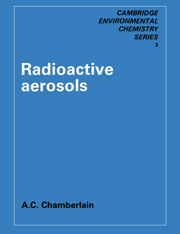Summary
Physical properties
The gases radon (222Rn) and thoron (220Rn) are formed as progeny of uranium and thorium in rocks and soil. They are emitted from the ground into the atmosphere, where they decay and form daughter products, isotopes of polonium, bismuth and lead, which either remain airborne till they decay, or are deposited in rain and by diffusion to the ground.
Radon and thoron and their decay products are the most important sources of radiation exposure to the general public, contributing on average about half of the total effective dose equivalent received from natural and man-made radioactivity (Clarke & Southwood, 1989).
The emanation of a radioactive gas from radium was observed by Madame Curie. In the atmosphere, radon diffuses and mixes with air like any other gas. Rutherford & Brooks (1901) obtained a value 8 × 10–6 m2 s–1 for the diffusivity of radon. Recent determinations are in the range 1.0 to 1.2 × 10–5 m2 s–1 at N.T.P. (Jost, 1960).
Radon is slightly soluble in water, and obeys Henry's Law. At 20°C the partition coefficient (amount of radon per litre of water at equilibrium divided by the amount per litre of air) is 0.26. Despite the low solubility, water supplies derived locally from granite and metamorphic rocks can be an important source of airborne radon in dwellings (Nero & Nazaroff, 1984; Hess et al. 9 1987). Radon is more soluble in fats and organic liquids, and the partition coefficient between air and human fat is about unity at 37°C.
- Type
- Chapter
- Information
- Radioactive Aerosols , pp. 1 - 60Publisher: Cambridge University PressPrint publication year: 1991



